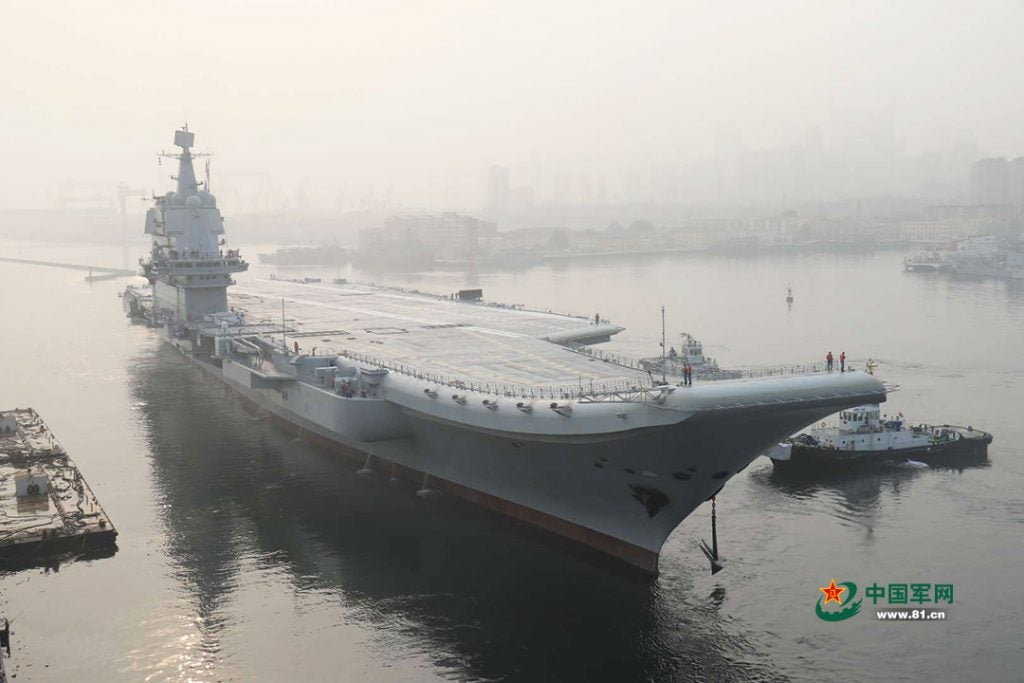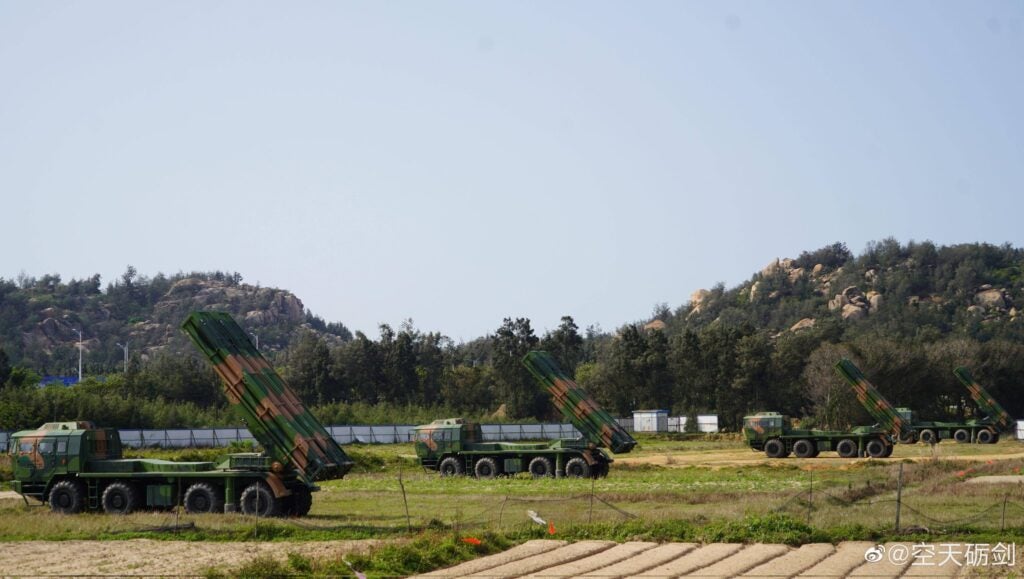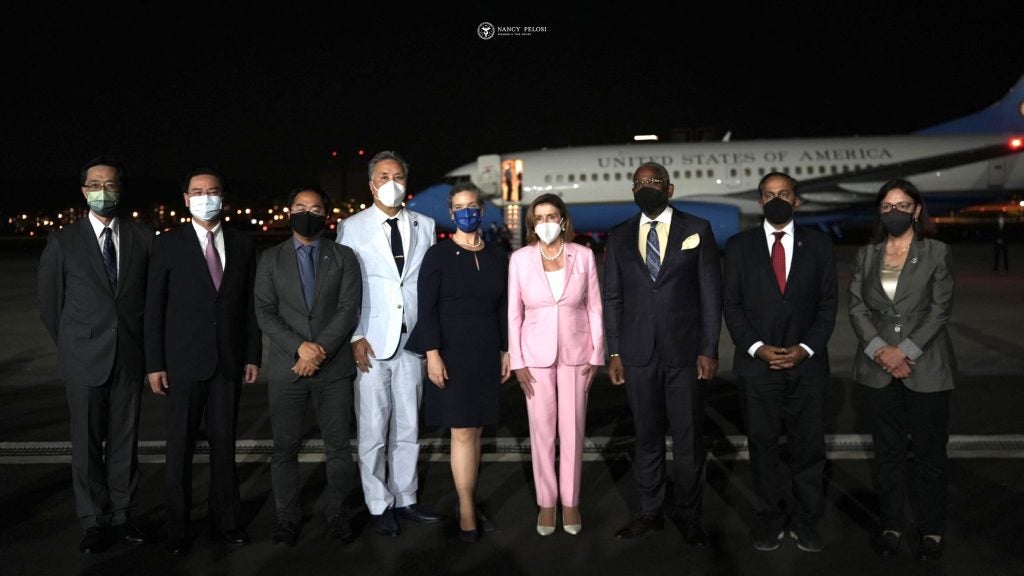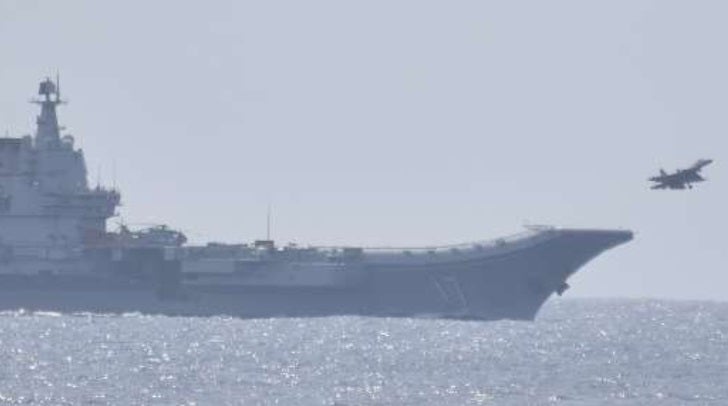Interview: Understanding The Messaging From China’s Joint Sword Exercises
China’s People’s Liberation Army conducted a series of military exercises off the coast of Taiwan between 8 and 10 April, in response to Taiwanese President Tsai Ing-wen’s visit to the United States, where she met with United States Speaker of the House Kevin McCarthy. The Joint Sword exercises drew attention for its simulated encirclement of Taiwan, and the first use of the PLA Navy aircraft carrier Shandong’s air wing in the exercises.
Overt Defense had the opportunity to speak with Daniel Rice, the United States Marine Corps University’s Brute Krulak Center for Innovation and Future Warfare’s resident China subject matter expert on what he found of interest from the exercises, and the different messages the exercises sent to Taiwan, the United States, and European nations.
All statements and opinions here are made in a personal capacity, and do not necessarily reflect the views of the Krulak Center, Marine Corps University, the United States Marine Corps or the United States government. This transcript has been edited for clarity.
To start things off, could you recap the Joint Sword exercises?
For the Joint Sword military exercises, my understanding of it is that it is in response to Taiwanese President Tsai Ing-wen’s meeting with US Speaker of the House Kevin McCarthy. It took place over three days, and the key component to it was it looked not so dissimilar from last August’s exercises when Speaker Pelosi had visited Taiwan. By that, I mean they practiced what seemed to be an encirclement around the island, including carrier operations off of the eastern coast. There was a heavy emphasis on integration across the services, which included the PLA Army, the PLA Air Force conducting sorties down in the southwestern portion of Taiwan’s ADIZ, the PLA Navy was conducting air operations with their J-15 wing off of the Shandong or Type 002 aircraft carrier off the eastern coast of Taiwan. The PLA Army long range artillery was used as well off the coast of the mainland, practicing precision strikes on ground based targets presumably on the island of Taiwan. The reason I say that is because one of the key things, at least in English media, was that these exercises were supposed to simulate strikes on critical sites in Taiwan. The PLA Rocket Forces was also part of these exercises, with its conventional and potentially nuclear ballistic missile capabilities.
What did you find interesting about the exercise?
One of the notable things for me would be the carrier operations, because the PLA is planning on fielding 5 aircraft carriers by 2030. Sitting where I sit at Marine Corps University, a lot of attention is paid to the naval component the PLA has, specifically these aircraft carriers and how they could be used in a potential conflict. If you’re familiar with carrier operations, one of the most difficult things to do to actually execute that mission set is to land on an aircraft carrier. The Type 002 Shandong is a ski-jump style aircraft carrier based on the original Varyag aircraft carrier purchased from Ukraine, and is an upgraded version of the Type 001 Liaoning. The landing component would be consistent across the different variants of aircraft carrier, and by that I mean with the new Type 003 Fujian carrier, landing operations across the Type 002 and Type 003 will be relatively similar, so it’s practicing a skill set for the air wing of the Type 002 carrier that could potentially influence or help to train naval aviation pilots for operations off of more advanced or more modern carriers like the Fujian or the Type 004, so that’s very interesting.
The second very interesting thing for me is the integration of the PHL-191. It’s the rocket artillery the PLA army has, one of its more modern systems. Integrating at least simulated strikes from the army artillery itself is interesting, because normally when western observers look at a China-Taiwan-US conflict, a lot of attention is paid to the PLA Rocket Force and the capabilities that the PLA Rocket Force brings to bear against Taiwan. But, even though the PLARF has a wide variety of short, medium, intermediate and long range ballistic missile systems, there are other missile systems the PLA has, one of them being the PHL-191 in the Army, as well as other missile systems with the PLA Navy, that are land based and very clearly demonstrated by this exercise are envisioned in being used in either a blockade or attack on Taiwan if it were to occur. So, I think integrating more clearly these rocket artillery and land based missile systems that are not within the PLARF is also a rather interesting development, and one that has popped up before, but it is clearly being highlighted now.

In terms of messaging, would you consider the act of the exercise itself as more or less aggressive than the exercises conducted in response to Pelosi’s visit?
From my understanding, I would consider it slightly less provocative. There are a couple of reasons behind that, but the first one is that the exercise was largely simulated strikes. There were live fire components to this, but as far as I saw, there were no missiles flying over Taipei.
Yes, that would be the standout.
Right, that is obviously radically provocative from the PLA side, and part of that could be that it’s not uncommon for the PLA to conduct exercises in or around Taiwan’s Exclusive Economic Zone, in its ADIZ et cetera when there are high level diplomatic meetings between the US and anybody in the Taiwanese government. So it’s not an uncommon thing, the thing that is uncommon between last August and this series of exercises is that they are obviously getting much larger in scale, they are getting more aggressive in terms of locations where they decide to actually enter the Taiwan ADIZ as one example, but also to conduct these kinds of carrier ops and shipborne operations. By more aggressive, I mean closer in to Taiwan, operating on the periphery beyond the Bashi Strait, beyond Taiwan’s eastern coast and looking more like encirclement over time. And that really had not happened until last August. Before that, most of these types of exercises were carried out on the western side of Taiwan, in what China considers its sovereign sea territory.
By operating further out, specifically off the eastern side of Taiwan, looking more like encirclement, incorporating various services of the PLA to execute long range fires and targeting solutions, that looks far more aggressive. This is the second large scale iteration of this kind of exercises, I suspect it will not be the last that we see, and we should probably anticipate these becoming more involved as PLA capabilities come online. Things in the future like H-20s participating once those are built and flying, incorporating new in-flight refueling systems like the Y-20 outfitted with aerial refueling capabilities, the KJ-600, the new airborne early warning and control platform anticipated to be used on the Type 003 with its electromagnetic launch system. Incorporating more of those into the battle space is something we will probably see in the future, as well as unmanned aerial and underwater systems to the extent that they can put them out there.

On the idea of the exercise being a less aggressive reaction, has this been reflected in statements made by PRC government officials or in state media?
To be fair, I have not tracked their official statements incredibly closely, but from what I have seen, it did seem that the official messaging was for Tsai Ing-wen to meet with Speaker McCarthy is about as close as you can get to crossing a red line, and these exercises were, like in the past, a way to show the PRC’s disapproval of this kind of meeting, show that they not only have the military capability to pose a credible threat to Taiwan, and that they are willing to use PLA capabilities as a show of force in their disapproval of this kind of political connection. I forget the exact wording that came out of the PRC, but it was something along the lines of “this is not tolerable, this is close to the fringe if not crossing the red line, please cease and desist”. But that is pretty common for these kinds of situations.

One of the arguments made during the Pelosi visit was the aggressiveness of the exercises and accompanying messaging was due to a need to placate the more nationalist fringe of the PRC citizenry. Have you seen anything suggesting that popular sentiments are similarly agitated by Tsai’s visit to the United States?
I’m going to give you a response that you might not love, but it’s the way I view it. Nationalism at large, and nationalist sentiment when agitated, is very, very difficult to stop or reverse. So in this instance, because this was an event happening in the US and not directly off the coast of China, I think there could have been slightly less nationalist agitation over the meeting. It’s very difficult when you’re playing the nationalist game to agitate a population if it’s not something that is immediately on the periphery or immediately noticeable by that population. In the instance of Pelosi visiting Taiwan, from the PRC’s point of view, this is a US diplomatic figure entering Chinese sovereign territory deemed a separatist province, and holding official meetings with the separatist government. That would be the official PRC stance. When it is the reverse, with the head of this separatist government going abroad and holding meetings in California, there is a little bit of a different message that comes across to the domestic audience in China.
Long story short, I do think there is a heightened sense of nationalism within China, not only because if you watch any of the media in Mainland China, there is this feeling of “the second century or the next 100 year goal is here”. That came with the National Party Congress that happened last year, where it was, no kidding, stated that “the first centenary goal has been accomplished, we’re moving on to the second centenary goal”. That really evokes a feeling of development and achievement within the population, and it sets the marching beat for “China is well on its rise to regaining its position as leader of the world order”, specifically under Xi Jinping. And with Xi Jinping getting his third term in office as the General Secretary and then getting reaffirmed with the National People’s Congress as the President for a third term, really solidifying in law his continuation of third terms in the titles he has, all of that creates a growing sense of nationalism and national pride affiliated with nationalism.
And when it comes to other countries not necessarily respecting what the PRC perceives as its sovereign territory, it will poke the bear, or in this case poke the dragon, so to speak. And that will cause a large reaction from the domestic population. Again, in the context of this trip by Tsai to the US, it is not as close to poking the dragon as it would be if McCarthy went to Taiwan, whether in the face of the public, or in the PRC official media stance that it would be US interests infringing on their sovereign territory.
Obviously, President Tsai and Taiwanese lawmakers perceive the exercises as a reaction to Tsai’s meeting with McCarthy, but the exercises also come after French President Emmanuel Macron and European Commission President Ursula von der Leyen’s visits to China. Would the exercises also be a message to Macron and von der Leyen?
Bottom line up front, yes. This is a message to Europe and the US. The message is slightly different, though.
For the US, the message is “hey, we have the military capability to project power and target systems on Taiwan if you continue down this path” of what they would say is breaking the one China policy, going against all of the agreements in place to solidify the status quo that currently exists, “then we have the ability to carry out a military reunification of Taiwan with the mainland”. That’s to the US.
To Europe, there is a radically different message, and it’s one that actually started to really pick up speed back during the Munich Security Conference. If you look at the verbage coming from Macron about Europe’s strategic autonomy, that specific phrase was used by (head Chinese diplomat) Wang Yi at the Munich Security Conference to describe how China saw the European security situation.
Now, why does that matter? It matters because if you’re looking at a potential conflict over Taiwan, the way that it is currently framed, it looks a lot like China versus Taiwan plus the US, plus coalition allies and partners, not only in the Indo-Pacific but also in Europe. And that is a losing proposition for China. With this idea of Europe’s strategic autonomy, part of that is trying to break apart the potential coalition that China could face if conflict were to erupt. And the effectiveness of that coalition’s response has been demonstrated to a certain degree by Russia’s war in Ukraine.
If you think back to the start of that conflict, Russia thought they were going to invade Ukraine, they were going to do it easily, there would be very, very little response from the international community, and it would be closed out in a short period of time. Although there has not been significant overt NATO support of Ukraine to the extent of literally sending in their own ground or air units, there has been a large international coalition response in the form of sanctions against Russia.
For China, that kind of international coalition response in the form of sanctions and economic damage would directly attack the credibility and authority that the Chinese Communist Party has, and one of its main tenets for maintaining its legitimacy to govern the country. You don’t have the economy to support it, then you lose legitimacy.
For Macron leaving and saying “you know, European strategic autonomy, we should investigate this”, echoing Wang Yi’s statements, the message to Europe is very much “you don’t want to be part of this fight, don’t get yourselves caught up in the fight by being dragged in by the US, try to establish your strategic autonomy” And so it is concerning that Macron is echoing those words.
The other thing that comes to mind is since after Macron’s interview was published, the Polish government and pundits from various European nations have been criticizing the statements Macron made on the way back from China. This seems like it’s achieving the CCP’s goals of causing internal divisions within the EU.
Yes, I would tend to agree. The one thing you also have to keep in mind is that unlike, for whatever reason, the US where we don’t pay a lot of attention to history, but countries in Europe, China, and other countries in the Indo-Pacific certainly do. And one of the things that has been fairly consistent is that European countries, specifically France, their interests have been a little bit independent of many other countries. And they take a lot of pride in their independence, especially when it comes to international affairs and military affairs. Amongst the European allies the US has, certainly France making strong statements about its autonomy would accord with history.
Other allies and partners such as the UK that are very, very close to the US, that are part of Five Eyes, saying that kind of thing, saying “strategic autonomy” and pushing for the independence of choice or moving away from being forced into a coalition would be much more radically damaging, and something that quite frankly would be unthinkable from the UK at this point in time.
Alongside all these headlines criticizing Macron, the other headlines asking whether or not the Taiwanese should start worrying about being invaded for real seems to be assisting the PRC in achieving its less overt messaging goals.
Yes, I would say so. If you’re saying the statements out of Macron, did that help the messaging goals on Taiwan, yes. It goes back to what I was discussing about this idea that the strength that the US has, and you will see this echoed in the National Security Strategy, is based on the collective power of allies and partners paired with the US. France is a US ally, they are part of NATO, they have been a US ally for quite a long time even though that relationship has its own tension points like the AUKUS deal. But fundamentally we are aligned in our goals, so to hear a strong US ally come out with different strategic messaging that would indicate slightly less support for any conflict over Taiwan certainly drives home the PRC’s message of “hey Taiwan, you know, if we decide to pull the trigger, then you might not have all of those partners and allies come and shore up your defenses, or come later on after the initial strikes to help maintain your autonomy”.
And that’s the messaging that China really wants to get across to Taiwan. You even saw it again, if you go back to the start of the Russia-Ukraine war, that some of the official messaging was “Taiwan, you might not have all these partners at your side that you think you do”. Same thing with the withdrawal from Afghanistan that the US went through. The messaging that came out was “Hey look, the US withdrew from Afghanistan, Taiwan, you think they’re going to show up for you?”
So yes, anything that supports that idea of peeling back the coalitions that Taiwan expects and really hopes to come to its aid does support the PRC’s messaging.

